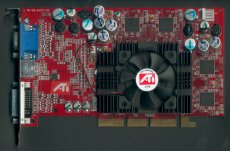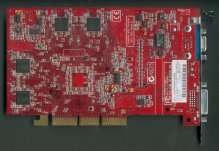Vendor: ATI Technologies Inc
Price: $399 (MSRP)

Kicking off the year with the NV25-powered GeForce 4 Ti series, NVIDIA once again set the performance standard for high end graphics cards. No sooner was this being announced and released, rumours of a reawakening of Matrox begun to be heard and, indeed, in June Matrox's 'Parhelia' was announced, a hybrid DX9 (Vertex Shader) and DX8 (Pixel Shader) part and the first consumer board to adopt a true 256bit bus memory interface. More intrigue occurred when Creative announced the purchase of the workstation graphics vendor 3Dlabs; 3Dlabs subsequently announced the P10 architecture, to be used on the 'Wildcat VP boards, with a highly innovative design geared towards programmability and flexibility for the workstation market rather than pure performance.
Thus far neither of the Matrox nor 3Dlabs parts have managed to shake NVIDIA's tree very much in the consumer space. While Parhelia features a number of innovative elements, performance has shown itself to be a little disappointing. And, although Creative has intent to bring 3Dlabs' parts to the consumer space, so far Wildcat VP and the P10 technology has remained firmly ensconced in the workstation space, resulting as yet in virtually no focus on the consumer market. What, you may have asked, is ATI planning?
We've known that 'R300' would be the next high end chip from the Canadian firm and we've also heard that the ARTx team that ATI purchased some time ago--and who were responsible for the graphics element in Nintendo's Gamecube--would be the mainstay of the design team. Beyond that it would seem that ATI kept its cards fairly close to its chest. Although DX9 Compliancy was expected, a few vague rumours of performance surfaced but were perhaps not really believed, especially in light that it was also supposed to be based on a .15um process - either this is correct and the performance rumours are wrong, or the performance rumours are correct and the process is wrong. R300 then started showing up in shows and, most notably, at E3 powering Doom III, and still people were left wondering what this consisted of.
Last month ATI finally announced Radeon 9700 based on the R300 graphics core. They allowed some member of the press to show relative performance numbers many of which proved to be rather surprising; now it's time to see how these relative performances translate into real numbers...
Radeon 9700 Goes PRO
Since the unveiling of the boards ATI appear to have shifted things around a little. Initially the announcements showcased Radeon 9700 test boards running with a core clock speed of 325MHz; however, ATI at that point would not pin this down to being the final specification speed, probably because they needed more time to assess the yield situation they were achieving from the chips coming back from the fab. However, ATI recently announced Radeon 9700 PRO and it transpires that this will be released at the full 325MHz core clock speed, but with a 310Mhz (620MHz effective, being DDR) memory speed, and with a Radeon 9700 (non 'PRO') introduced at a later date, presumably with slightly lower clock speeds. The Radeon 9700 PRO is what has been passed to Beyond3D for testing.
Core Specifications
Here's a quick overview of some of the key specifications of the chip and board:
- .15µ Silicon Process
- ~110 Million Transistors
- 325Mhz Core Clock Speed
- 8 Rendering Pipelines with 1 texture sampling unit per pipe giving 2.6Giga Pixels / Texels Fillrate
- 128MB of 310Mhz DDR RAM on a 256Bit External Bus giving 19.8GB per second actual memory bandwidth
- Up to 16 textures per pass
- 4 Parallel Geometry Pipeline giving a peak Triangle throughput of 325Mtri/sec
- Dual Independent Display Controllers with two 400MHz RAMDAC's and Integrated TMDS Transmitter
Features:
- DirectX Version 9.0 Compliancy
- TRUFORM 2.0 Higher Order Surface Processor
- SMARTSHADER 2.0
- DX Vertex Shaders 2.0
- DX Pixel Shaders 2.0
- HYPERZ III Memory Optimisations
- SMOOTHVISION 2.0
- Up to 6X FSAA
- Up to 16X Anisotropic Filtering
- VIDEOSHADER Video/DVD Playback
- HYDRAVISION Display Software
Note: For a list of presently supported DirectX8.1 caps and OpenGL Extensions please see here.


